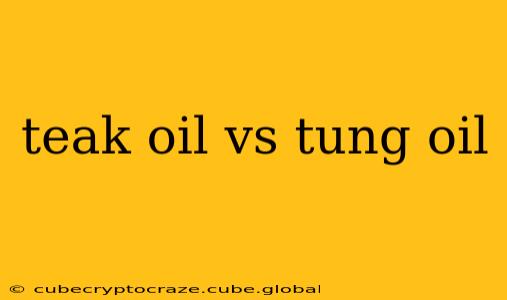Choosing the right oil for your wood finishing project can be tricky. Two popular choices often top the list: teak oil and tung oil. While both offer protection and enhance the beauty of wood, they have distinct properties and applications. This comprehensive guide will delve into the key differences between teak oil and tung oil, helping you make an informed decision for your next project.
What is Teak Oil?
Teak oil isn't actually extracted from teak trees. Instead, it's typically a blend of mineral oil, linseed oil, and sometimes other drying oils, often with added solvents and preservatives. It's marketed as "teak oil" because it's often used to treat teak furniture, which is naturally highly weather-resistant. The primary purpose of teak oil is to protect wood from the elements, offering water resistance and UV protection. It penetrates the wood moderately well, leaving a relatively thin protective layer.
What is Tung Oil?
Tung oil, on the other hand, is a true botanical oil extracted from the seeds of the tung tree. It's a highly durable, natural finish known for its superior water resistance and ability to penetrate deeply into wood. Unlike teak oil, pure tung oil forms a hard, protective shell that is highly resistant to weathering and abrasion. However, tung oil takes significantly longer to dry than teak oil.
Teak Oil vs. Tung Oil: Key Differences
| Feature | Teak Oil | Tung Oil |
|---|---|---|
| Composition | Blend of oils (mineral, linseed, etc.) | 100% Tung oil (pure) or blended versions |
| Penetration | Moderate | Deep |
| Drying Time | Relatively fast | Significantly slower |
| Durability | Moderate; needs reapplication frequently | High; more durable and long-lasting |
| Water Resistance | Good | Excellent |
| UV Protection | Good | Good |
| Cost | Generally less expensive | Typically more expensive |
| Application | Easier to apply | Can be trickier to apply; multiple coats needed |
Which Oil is Right for My Project?
The best oil for your project depends on your priorities and the type of wood you're working with.
Choose Teak Oil if:
- You need a quick and easy solution: Teak oil dries faster and is easier to apply than tung oil.
- You're working on a project that doesn't require extreme durability: It's suitable for indoor furniture that won't be subjected to harsh conditions.
- Cost is a primary concern: Teak oil is usually more budget-friendly.
Choose Tung Oil if:
- You need a highly durable and water-resistant finish: Tung oil provides superior protection against the elements and wear and tear.
- You're working on outdoor furniture or projects exposed to harsh weather: It's ideal for decks, boats, and other exterior applications.
- You want a finish that will last longer: Although more time-consuming to apply, the durability of tung oil makes it a worthwhile investment in the long run.
How Long Does Teak Oil Last?
The lifespan of teak oil depends heavily on the application and environmental factors. Typically, you'll need to reapply teak oil every 6-12 months, or more frequently if exposed to harsh weather or heavy use.
How Long Does Tung Oil Last?
Pure tung oil, when applied correctly, can last for several years, often requiring only occasional touch-ups. This longevity is a significant advantage over teak oil.
Is Tung Oil Food Safe?
Pure tung oil, once fully cured, is generally considered food-safe for cutting boards and other kitchen surfaces. However, it's crucial to use 100% pure tung oil and allow it to cure completely before use. Always check the product label for specific food-safe certifications.
Can I Mix Teak Oil and Tung Oil?
While you can technically mix teak oil and tung oil, it's generally not recommended. The different compositions and drying times can lead to an inconsistent finish and potentially reduce the overall performance of both oils.
This detailed comparison should help you choose between teak oil and tung oil for your next wood finishing project. Remember to always follow the manufacturer's instructions for application and safety precautions.
